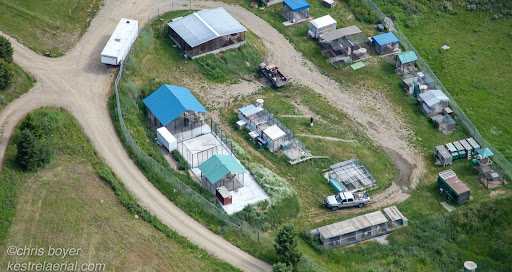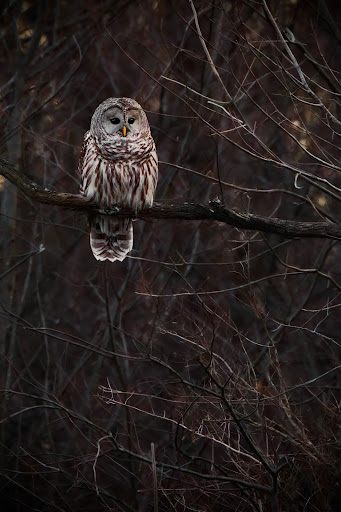It’s about two hours before sunset, and the small wildlife refuge’s fifty-car parking lot has just reached maximum capacity. A few hours north of New York City and several miles out through rural backroads, a surprising flurry of concentrated human activity materializes. Cars that have been driving for several hours defeatedly u-turn at the end of the lot and anxiously search for a makeshift parking spot along the driveway. Meanwhile, dozens of bundled bodies, some dressed in strikingly ironic camouflage, walk briskly out into the grassland with their cameras. Rows of photographers with lenses that could be spotted from outer space decidedly stake their claim amongst the crowds, and wait.
And what, exactly, are all of these people waiting for?
A single pair of owls. They’re highly sought-after short-eared owls – an endangered species in New York State and a highly popular social media subject. News has traveled quickly through the photography community that this pair has returned to their wintering grounds here at the refuge after about nine months away. Sunset is just around the corner, and the pair is bound to appear soon to commence their evening of hunting.

It’s December, and for the next few months, hundreds of photographers will visit from all over the state and beyond, to try their luck at snapping the ultimate owl shot. Who wouldn’t want an epic photo of a beautiful, rare owl to show their friends? And it’s true – it’s not like these people are actively harming the owls. But this annual assembly of hungry photographers begs the question – how far can we go as wildlife photographers before we’ve gone too far?
Ethical wildlife photography is a term that’s thrown around a lot these days in the photography community. But defining it isn’t exactly straightforward. Basically, ethical wildlife photography is the conscious practice of prioritizing the wellbeing of the wildlife being photographed. In our modern era of virtual “likes” and instant gratification, there are thousands of eager people with cameras out there trying desperately to get that “perfect” shot, often by any means necessary, and unethical behaviors in the field are sadly extremely common. While it’s tricky to define exactly what ethical wildlife photography is, it may be easier to define what it is not. Some common unethical wildlife photography practices are:
Wildlife harassment
This refers to a wide variety of behaviors that disturb and ultimately harm wildlife. Some examples might be waving your arms to entice a resting bird to fly to get an exciting in-flight shot, or quickly approaching a fox for a closer portrait shot but ultimately scaring him, causing him to drop his kill and run away. Energy is precious for wild animals, so the energy they spend or lose because of our presence can seriously affect their chances of survival. It may not seem like much, but an extra flight or a lost meal may very well be the difference between having the energy to outrun a predator or not. Wildlife harassment can also be much more subtle, like visiting a nest too often, or even just getting too close to an animal (for example, it is a federal crime under The Marine Mammal Protection Act to even come within a certain distance of a marine mammal). A good rule of thumb here is if you are visibly changing the behavior of and/or stressing out a wild animal in order to get a photo, you’ve probably gone too far.
Baiting
This is an especially common practice in bird & owl photography, though baiting can be used with many types of wildlife. Many photographers will actually bring mice (dead or alive) into the field to offer wild owls for an up-close hunting or flying shot. However, baited owls are particularly likely to become habituated to humans, often enticing them closer and closer to more populated areas like parking lots and roadsides. Many owls that are regularly baited meet their tragic fate with car collisions. And although this behavior is mainly associated with owls, they aren’t the only ones who are subjected to it. Ever heard the saying “a fed bear is a dead bear”? Wild animals who are fed by humans often learn to associate humans with food, and consequences include becoming unafraid of cars and roads, being unable to secure food independently, and/or becoming aggressive towards humans, which often results in the animal being put down. It isn’t rocket science that feeding wildlife, especially predators, isn’t a great idea.

Photo dishonesty
This one may surprise you, although it’s probably the most common of all the unethical wildlife photography practices. Ever come across a whimsical close-up photo of a striking black wolf?

Or an epic shot of a hawk flying with perfectly fluffy white clouds in the background? Or maybe a seemingly too-good-to-be-true rare cat wandering through a glorious mountainside? Spoiler alert: chances are you aren’t looking at an authentic wildlife photograph. With editing softwares and AI becoming increasingly accessible, these faux creations are popping up all over the place, often portrayed as real, unaltered shots. Similarly, photos of captive animals portrayed as wild are also extremely common. There are many wildlife “parks” or “sanctuaries,”, in addition to zoos, where photographers can pay entry to photograph captive animals close-up. But the ethical standards of many of these parks is hazy at best and animals are often kept in less than desirable conditions. Triple D Wildlife and Animals of Montana, two notorious roadside operations in Montana, have long been popular amongst photographers looking to get that dream shot of large predators such as wolves, bears, and big cats.

And aspiring amateurs aren’t the only ones frequenting these types of facilities. David Yarrow, a highly successful and globally famous photographer (yes, the same guy appearing to bait the fox in the earlier photo), has often utilized captive wildlife in his shoots. In fact, he is good business friends with Troy Hyde, the owner of the recently shut-down Animals of Montana, despite the farm’s extensive history of disturbing violations and charges including wildlife trafficking, animal abuse, enclosure violations, employee attacks (at least 2 fatal), escaped animals, and so on. There’s no getting around the fact that paying these facilities for wildlife photoshoots directly supports and perpetuates the exploitation and mistreatment of wild animals.

© Susan Fox
And while artificially altered and captive animal photos may be visually appealing, they diminish and draw the attention away from authentic wildlife photography and set impossibly high standards, therefore encouraging further unethical behavior. Honesty and transparency about the stories behind our photographs is important for both wildlife and humans alike. I am a strong believer of inquiring about a photo if there is any question about its legitimacy as a fully wild, organic, and ethical capture. If you see a photo that looks too good to be true, it probably is.
I always prioritize the well-being of the wildlife I am photographing and am passionate about doing everything I can to maintain the most ethical possible standards. If you would like further details about any of my photos, contact me and I will gladly share the story behind the image with you.
Ethical Wildlife Photography DOs:
- Keep your distance. Use a telephoto lens when possible to maximize the distance between you and your subject. If you notice an animal changing their behavior or walking away from you, give them space.
- Follow the rules. Many parks/preserves have strict rules against things like drones, dogs, bikes, etc. Stay on trails – doing otherwise can have serious impacts on sensitive vegetation and habitats.
- Share locations sparingly. While lots of people want to see interesting wildlife, sharing the locations, especially of vulnerable species, raptors, or nesting birds, can have serious impacts on the animals.
- Be respectful. To the wildlife, to their habitats, and to fellow photographers. Most aspects of ethical wildlife photography are intuitive – trust your gut, be willing to examine your own actions, and always put the wildlife first!
While there remains substantial gray area in what is considered ethical wildlife photography and what isn’t, it’s at the very least something we should all be thinking and talking about as wildlife photography creators and viewers. While I was in New York this past winter, I myself was one of the many people who made the pilgrimage to see the short-eared owls. Yet on my drive home that night I was thinking not about the photos I took, but about the ethical concerns that were associated with the affair.
How was the presence of several dozen cars and nearly a hundred people every day affecting the endangered owls – not to mention the rest of the animals on the refuge? What impacts were all of the overflow cars parked along the edges of the protected grasslands having on the soil health, edge habitat, and air quality? Were the owls and other wildlife becoming too accustomed to humans and vehicles?
I don’t know that there are any clear answers. And while these ethical concerns are far more subtle than forcing a captive grizzly bear to perform tricks for a photoshoot or outright photoshopping a fake animal into a photo, I do think that these types of questions are nonetheless important and deserve serious and regular consideration.

There was actually another avian resident at the refuge the day I visited whose presence, though generally not considered a particularly exciting species to spot, was extremely powerful. While all 80 or so of us photographers squinted desperately to see the short-eared owls a quarter mile out into the grasslands, we had no clue that another owl had joined us. She sat silently on a low branch in the row of trees directly behind our backs; who knows how long she sat there watching us as we watched the shorties before anyone noticed her. She was a gorgeous young barred owl, and I learned that she and her twin brother were born on the refuge earlier in the year. But sadly, just a few days prior, her brother was struck and killed by a car on the road bordering the refuge. And further, he wasn’t the only owl to be killed by a car near the refuge this past winter. I couldn’t help but feel an immediate sense of guilt and responsibility.
She sat on her perch calmly, wise as an owl could be, slowly studying the long row of anxious photographers, almost as if to solemnly suggest, “is all of this really worth it?”